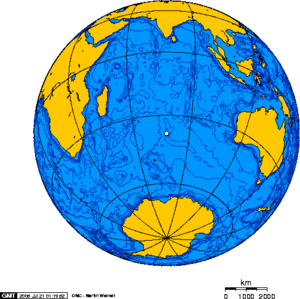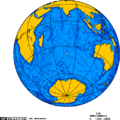Amsterdam wigeon facts for kids
Quick facts for kids Amsterdam wigeon |
|
|---|---|
| Conservation status | |
| Scientific classification | |
| Genus: |
Mareca
|
| Species: |
marecula
|
 |
|
| Location of Île Amsterdam | |
| Synonyms | |
|
Anas marecula |
|
The Amsterdam wigeon (Mareca marecula) was a special kind of duck. It was also called the Amsterdam Island duck. This duck lived only on Île Amsterdam (Amsterdam Island). This island is part of the French Southern Territories. The Amsterdam wigeon could not fly. We only know about it from its bones. Sadly, it became extinct, likely because of seal hunters and the rats they brought to the island.
Contents
What Was the Amsterdam Wigeon?
The Amsterdam wigeon was a type of waterfowl. This means it was a bird that lived near water, like ducks and geese. It was endemic to Amsterdam Island. This means it was found naturally only in that one place in the world.
A Duck That Couldn't Fly
Scientists know the Amsterdam wigeon was flightless. This means it could not fly. Its bones show it had strong legs. But its breastbone and wings were smaller than ducks that can fly. This design helped it walk and move around on the island.
How We Learned About This Duck
The Amsterdam wigeon is only known from its bones. No one ever saw a living one and wrote about it in detail.
Early Sightings and Discoveries
In 1696, a person named William de Vlaming visited Amsterdam Island. He wrote about seeing "four-footed animals" in the reeds. Since there are no native land mammals on the island, he might have seen these ducks. They could have looked like small animals moving through the plants.
No naturalists, or scientists who study nature, visited the island until 1874. By then, the island had many rats from visiting ships. The Amsterdam wigeon was already extinct.
Finding the Bones
The first bones of this duck were found in 1955 and 1956. More bones were found in 1987. Scientists found bones from at least 33 different ducks. These bones showed it was a very small duck. It had a short, pointed bill, like other wigeons.
The bones also told scientists that the duck likely did not live right on the coast. Its bones were found from sea level up to 500 meters high. This suggests it lived more inland on the island.
Why Did It Disappear?
The Amsterdam wigeon became extinct around the year 1800. The main reasons for its disappearance were likely humans and the animals they brought.
Human Impact
Visiting sealers came to Amsterdam Island. They hunted seals for their fur and oil. These sealers might have also hunted the easy-to-catch, flightless ducks for food.
Introduced Animals
The sealers' ships also brought rats to the island. Rats are not native to Amsterdam Island. They are very good at finding and eating bird eggs and chicks. They also compete with birds for food. The rats likely played a big part in the duck's extinction.
Other Similar Ducks
On Île Saint-Paul (St. Paul Island), which is about 80 kilometers away, explorer John Barrow mentioned a small brown duck in 1793. He said it was "not much larger than a thrush". This duck was a favorite food for the sealers living there.
This duck on St. Paul Island would have been a different species. But it shows that other islands in the area might have had their own unique flightless ducks too.
Images for kids



